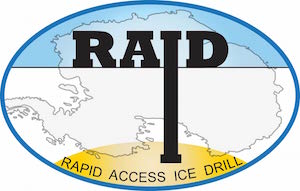By John Goodge and Jeff Severinghaus.
On January 16, 2020, RAID successfully drilled through the glacial ice at Minna Bluff and recovered rock core from beneath the subglacial bed at a depth of 681 m, a new record for deep ice exploration in Antarctica. It was a fantastic day for RAID, and for us as PI’s it was literally a dream come true! There was a joyful scene on the drill rig that day, with the entire camp on deck to see what we had worked so hard to bring up. Here’s how it unfolded.
Earlier, on January 10th, we were drilling progressively deeper in ice, trying to find the bottom of glacial ice. A radar profile flown across Minna Bluff a few years ago showed the base of the glacier overlying ‘rock’ to be at a depth of about 600 m (1,968 ft). With nervous anticipation, we passed this depth over the previous days and were probing ever deeper, expecting to hit geological materials at any point. At times, we could see dark specks of grit coming up with the ice cuttings, and we scraped off mud that was caked on the insides of filter socks, telling us that we were getting close.
Then at a depth of 677 m (2,220 ft) we saw the drill’s torque go up, we felt vibration through the drill string, and the drill’s load-on-bit gauge spiked. We immediately knew it must be a hard material, but was it subglacial rock? Since we had been getting ‘dirty’ ice shavings already, we pulled out the central ice-cutting bit on a wire line and checked the cutting teeth. They had plainly visible knicks and scratches indicating contact with some kind of material harder than ice, and certainly harder than metal. Rock?
At this point, thinking we must be really close to bedrock, we decided to start coring. We lowered the coring assembly to the bottom of the drill string on a wire line, where it latches in to the outer ice cutting bit. Unfortunately, we had a lot of trouble getting fluid circulation back, which is needed to cool the bit and remove the cuttings produced during coring. It seemed that the coring assembly was getting packed off with ice cuttings because the waterways were not large enough (see earlier post). Finally, we managed to take a core! As always with RAID, there was good news and bad news. The good news was that it was a good quality core of bubbly glacial ice. That means the coring bit works for ice and we can, in fact, recover short cores of deep ice. The ‘bad’ news was that it was only ice, not rock as we were hoping.
On the 16th, after additional coring attempts but getting little recovery, we pulled up what felt to the drillers like an intact core. After a fair bit of coaxing because of clay-rich mud adhering to the inside of the core barrel, we extracted our first real core of basal subglacial material! Because these cores come out bottom first, the first thing we saw was about 30 cm of stubby cylindrical sections and broken pieces of hard, dry till. It was sandy and gritty with small rock fragments. Above that was another 15 cm of firm, gritty mud. Next were loose ice cuttings and platy discs, followed above by about 75 cm of layered and banded ‘dirty’ ice, ranging from white to brown color, in a very complete core section. This single core run is incredible — in essence, we recovered in a single meter-long core an intact sequence across the glacial bed, from ice and banded ice above, downward into soft and compacted till! We had long wondered about what it would be like to core across this glacial-geologic boundary, and suddenly we had it!
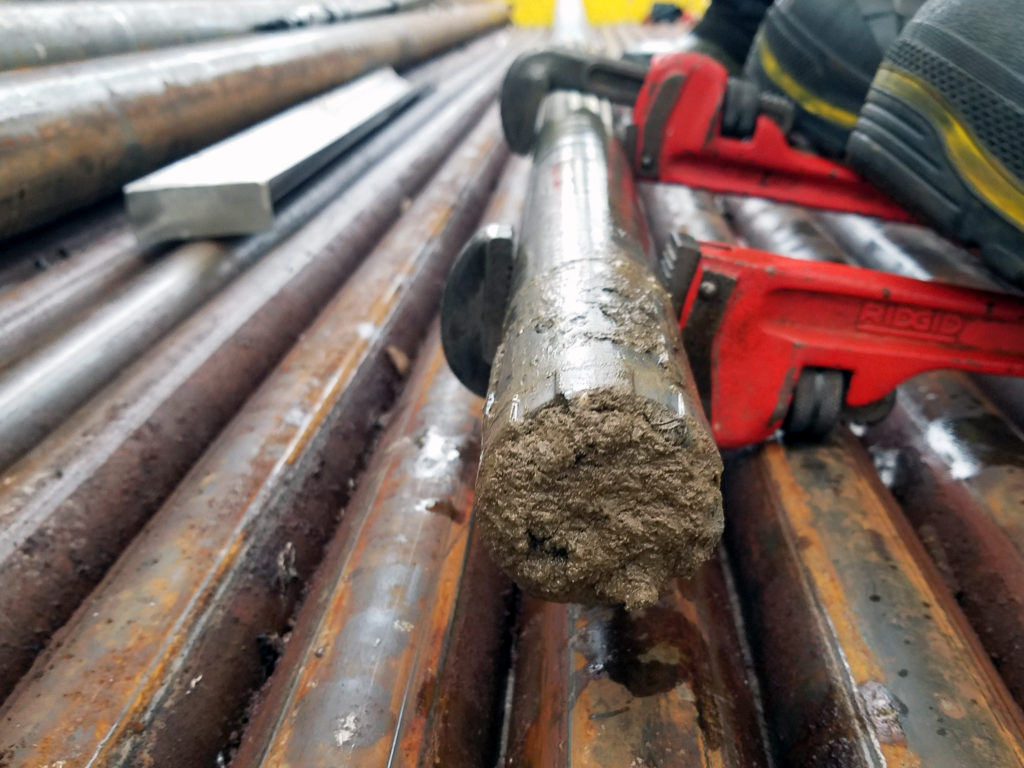


After that very promising coring run, we continued bringing up small bits of glacial debris, mostly loose, muddy material containing visible small pebbles of dark-colored rock. First it was thick, dark-brown gritty mud. Then we cored a dry, compacted, hard mud matrix containing pebble-size rock fragments and other debris. We were now at 679 m (2,227 ft). It seemed certain that it was glacial till from the glacier’s base, and the poor recovery was likely because of its unconsolidated nature. So we kept trying to go in for more.

Then shortly later around dinner time, we pulled up what seemed like a mostly full 10-foot core barrel. This is great! We set it on the drill deck to drain, then went to eat. Chris, the drilling supervisor, went back out to the drill right after dinner and radioed to John in a deadpan tone — “It’s not what you were expecting.” Tails between our legs, we walked reluctantly back out to the drill, anticipating more ice. That would mean that we were not really at the base of the glacier, but rather just another in a series of ‘false bottoms’. Instead, to our delight and amazement, as we arrived Chris and Dave pushed out a beautiful, solid, continuous rock core a little over 2 m in length (7 ft)! It was a spectacular lithified (rock) glacial tillite made up of a brown matrix containing a medley of rock clasts of different sizes, shapes and colors. When Chris had said we were not expecting this, he was taking a playful opportunity to yank our chains, but he was also right on!

This first rock core is a sight to behold. The rock clasts are undoubtedly eroded from a volcanic terrain like what makes up Minna Bluff just a few kilometers to the north. It’s a hodgepodge of different rock types, each one telling a different story about volcanic eruptions, shallow subsurface injections of partly crystallized magma, and hydrothermal alteration like one would see forming in a volcanic or geothermal area such as Yellowstone. This core also tells a lot about the subglacial processes at work. By coring through dirty, banded ice into soft till and then eventually into lithified tillite, we were able to capture a nearly continuous history of older till that was subsequently transformed into rock, which was itself then overridden by recent till that serves as the active substrate to the small modern glacier at Minna Bluff. It’s a spectacular geological and glacial story contained within just a few meters of core.

Everyone is ecstatic! After first thinking that we had cried wolf yet again, everyone from camp came out to see and touch actual rock core. Perhaps nothing captures the feeling of the moment like this photo from Hailey that says “We did it!”.
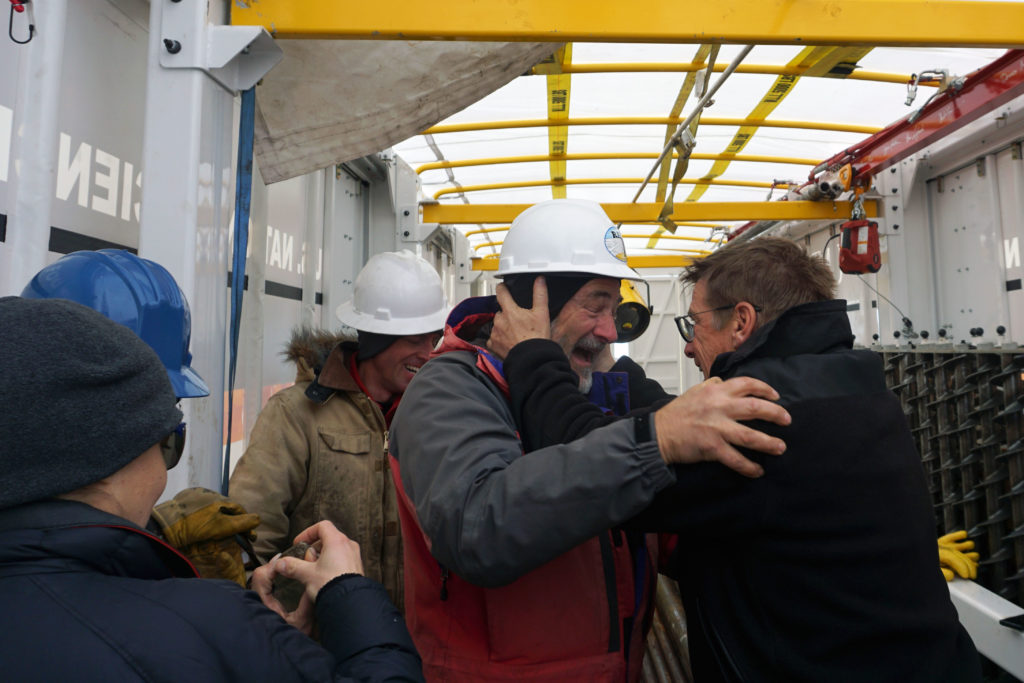
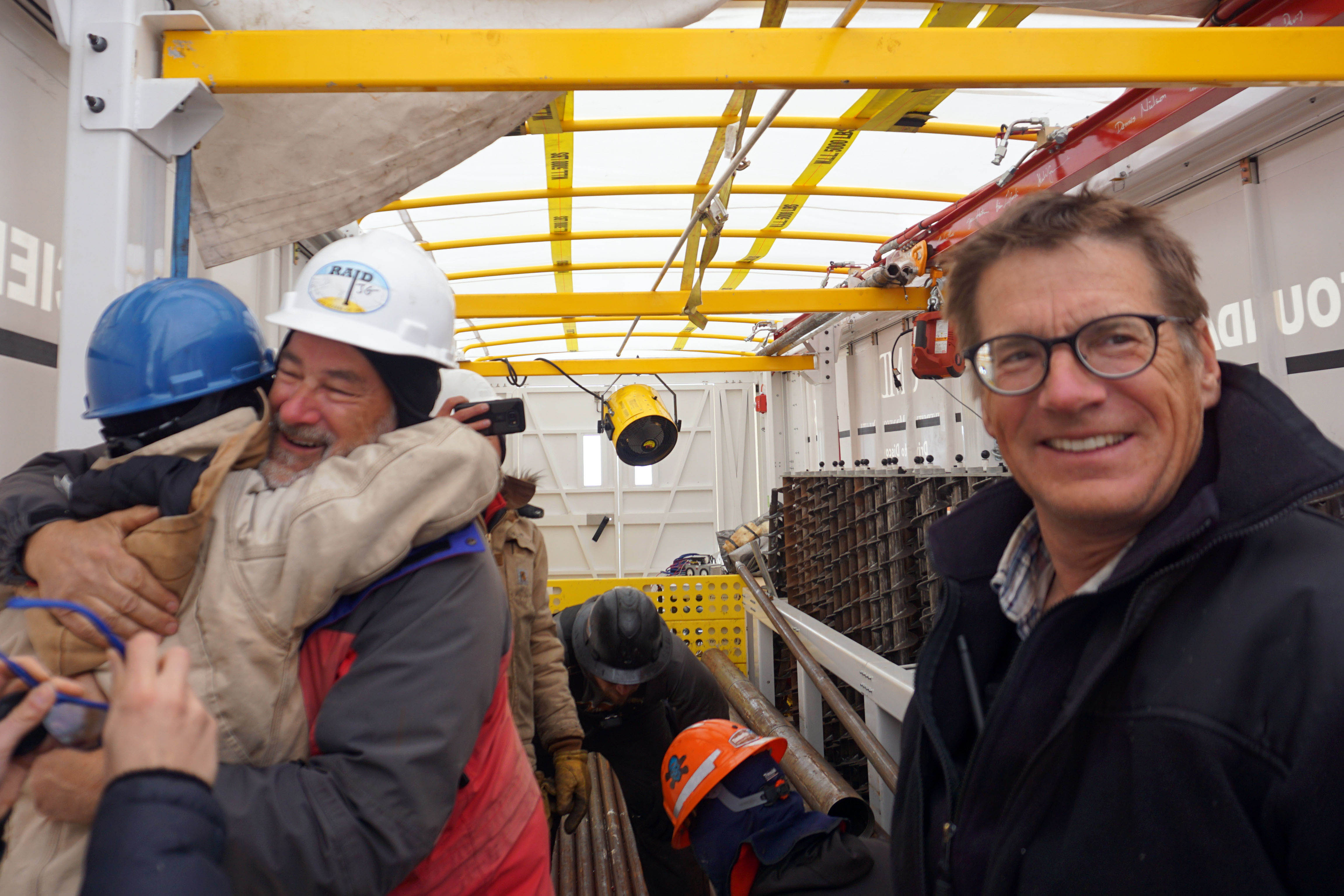


Why are we so excited? It’s amazing to finally see RAID do what it was designed to do, nine years after we started the project. We certainly had our internal doubts when things went sideways or broke, but validation of drilling deeply in ice is a huge accomplishment. Second, we just drilled across the base of an active glacier, and it’s not a small mass of ice in an alpine valley but rather is a good part of a kilometer thick! Last, getting our first rock core — in its natural context underlying basal ice and till — is extremely gratifying. RAID really can probe the deep glacial environment and core across the ice-rock interface. Plus, it’s just an aesthetically gorgeous rock!
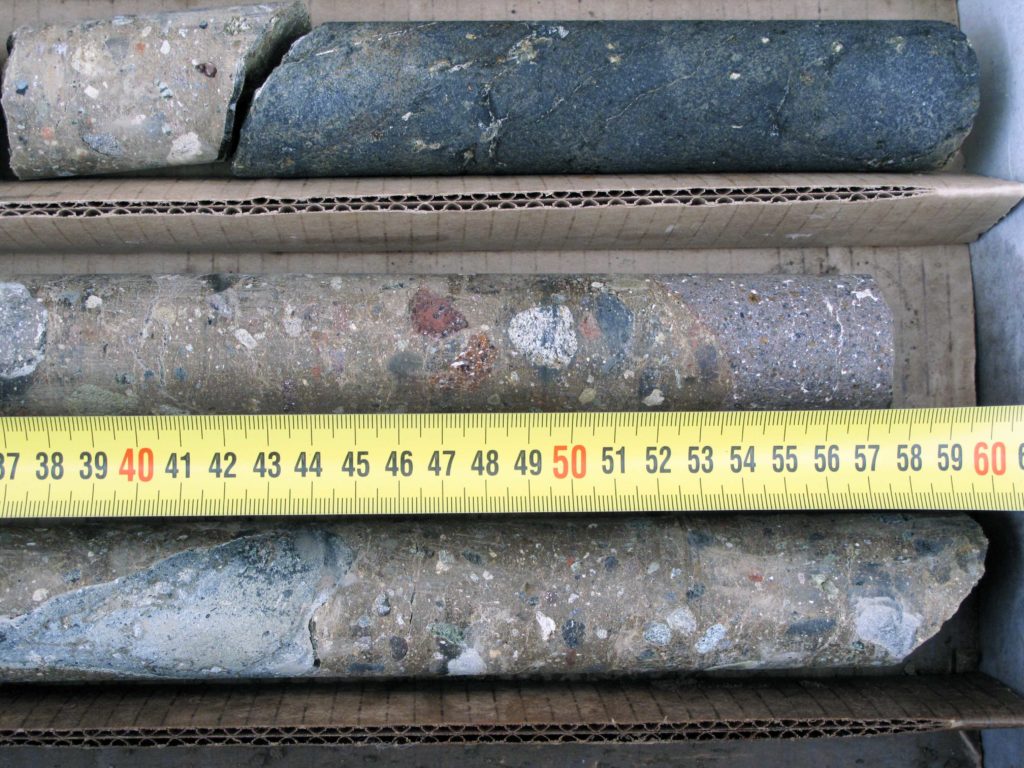
We decided to name this breakthrough borehole “Deep Together” — reflecting the dual significance of making a deep borehole in ice to get to bedrock, and that we did it together as scientists, drillers, and our camp support staff. And even though there were just twelve of us here to witness the big event, there are many dozens of other people who have been a part of RAID over the past few years during conceptualization, design, fabrication, and testing. To everyone involved, we thank you for all of the contributions you have made. It all adds up to a tremendous team effort.
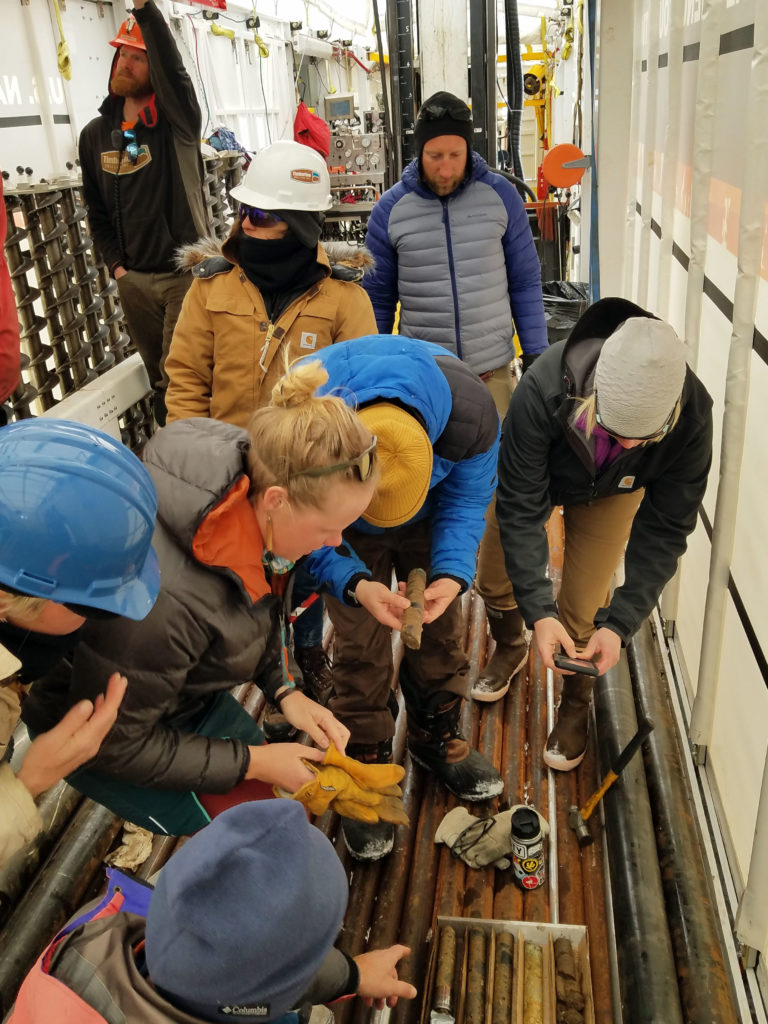
We owe a debt of gratitude to the drillers from Timberline who persisted through a seemingly endless series of problems to arrive at this point (see earlier posts). To Chris, Dave and Thor — thank you! Also, to Jay — we would not have reached this point without you.


Where do we go from here? We’ve since moved on to another drill site at Minna Bluff to start a new hole for further drill experimentation and development. Having already reached most of the major milestones planned for this season, we will be ready to take RAID on its next journey — to the polar plateau.

Photos by John Goodge, Hailey Gruber, Jay Johnson and Delia Tosi.
The views expressed here are personal reflections that do not represent either the RAID project or the National Science Foundation.
